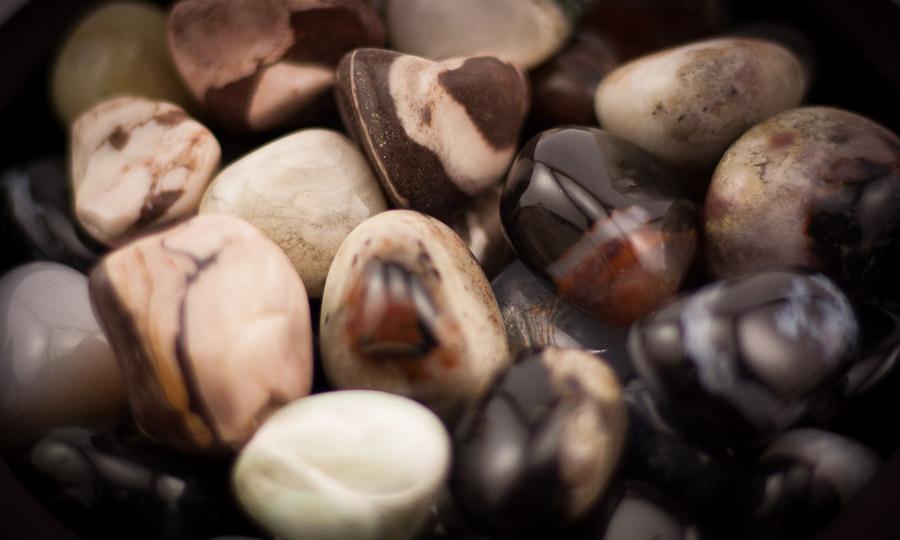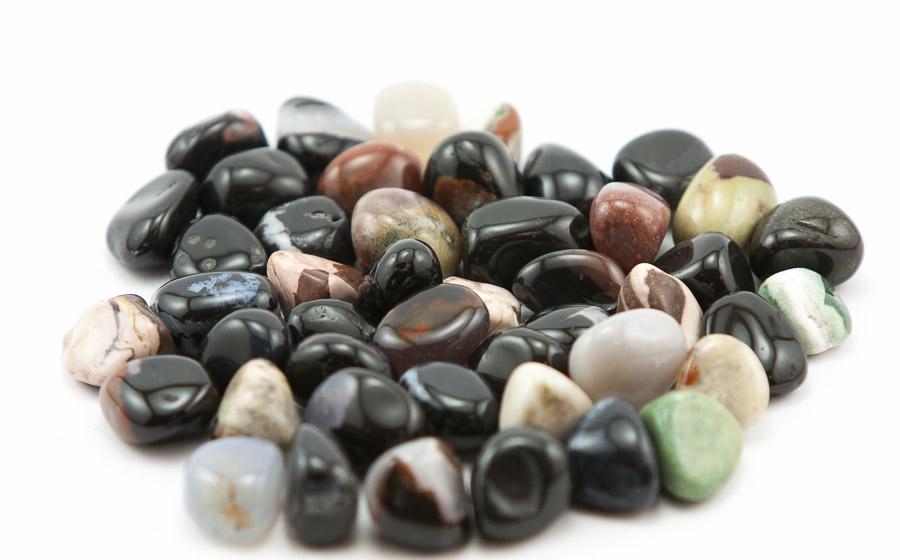You will not be allowed to compare more than 4 products at a time
View compareZebra Jasper Tumbled 1 lb
Zebra Jasper Tumbled 1 lb
Estimate delivery times:5-8 days.
Flat Rate Shipping and FREE Shipping on orders more than $100.
About This Product
Zebra Jasper – The Stone of Grounding Contrast
Poetic Introduction: Zebra Jasper is easily recognized by its bold black-and-white stripes, with alternating bands that create a dramatic, zebra-like pattern across its surface. Polished to a smooth, glossy finish, each stone feels cool and solid in the hand, revealing wild swirls of contrast that echo nature’s untamed artistry. It is grounding yet striking – like day and night dancing together in one stone. The black veins meander through white plains (and sometimes earthy browns or grays), evoking a sense of organic energy frozen in time. This gemstone’s presence is both earthy and exotic, a harmonious blend of light and dark that captures the yin and yang of the natural world in a single, silky-smooth pebble.
Historical and Cultural Background
Throughout history, varieties of jasper (including Zebra Jasper) have been treasured as protective talismans and symbols of balance. Ancient and indigenous cultures often revered jasper as a sacred stone of the earth – one that offered grounding and safekeeping to those who carried it. In some tribal traditions, healers and priests wore Zebra Jasper as a protective amulet to ward off negativity. The striking duality of its colors made it a natural emblem of duality and unity; even in far-off civilizations, the black-and-white stone was associated with the balance between opposing forces. Jasper in general was known as a Warrior’s Stone in the Middle Ages, believed to impart courage and strength. Legends abound in which jasper adorned the weapons of heroes – for instance, lore claims Zebra Jasper decorated the sword of the mythical hero Siegfried. Whether used in tribal ornamentation or cherished as a gift from the earth, Zebra Jasper has long been connected to a primal, grounding energy that links humans to the soil beneath their feet.
Metaphysical Symbolism
Zebra Jasper is celebrated in metaphysical circles as a stone of yin-yang balance and unified opposites. Its black and white bands symbolize the harmony of masculine and feminine energies, dark and light, self and shadow – teaching that these seeming opposites can complement and enhance each other. This crystal is often used for grounding and protection, creating an energetic shield that centers the mind and safeguards against negativity. Holding or meditating with Zebra Jasper is said to instill a deep sense of stability and motivation: it “grounds” you to the Earth while also spurring you to reach for your goals. Many believe it can boost physical energy and endurance, making it a favorite for those seeking an extra push to turn dreams into reality. Spiritually, Zebra Jasper encourages a state of equilibrium – aligning the chakras (especially the Root Chakra) and balancing one’s aura so that stress and overthinking give way to calm confidence. In essence, this stone embodies the unity of polar forces, reminding us that within life’s contrasts lies the potential for harmony, wholeness, and spiritual equilibrium.
Decorative and Luxury Appeal
Decorative Uses: The distinctive beauty of Zebra Jasper makes it a prized material in both jewelry and interior decor. Jewelry designers love its bold pattern – the stone is often cut into round beads for necklaces and bracelets or shaped into smooth cabochons for pendants, rings, and earrings. A strand of Zebra Jasper beads or a polished pendant becomes an eye-catching statement piece, each with its own one-of-a-kind stripe pattern. The monochromatic palette also lends itself to masculine designs; men’s cufflinks, signet rings, and even watch inlays have featured Zebra Jasper to add a sophisticated yet earthy touch. Beyond personal adornment, this gemstone shines in home and office decor. Craftsmen carve Zebra Jasper into small figurines, animal sculptures, or tribal masks, celebrating the natural contrast in themes of wildlife and spirituality. Smooth palm stones and spheres of Zebra Jasper serve as both tactile meditation tools and striking décor accents – their black-and-white swirls add an element of modern organic style to any space. Many interior designers incorporate Zebra Jasper in feng shui arrangements or tabletop displays, using bowls of tumbled stones or bookends made from sliced Jasper to invite balance and natural beauty into a room. From feng shui practitioners to art collectors, people are drawn to how this stone effortlessly complements both masculine and feminine aesthetics: it can enhance a minimalist black-and-white office or bring a grounding element to a colorful bohemian living room. Whether as a luxury carving, a piece of jewelry, or simply a polished specimen on a shelf, Zebra Jasper infuses spaces with its elegant contrast and the calming, grounded energy of nature’s art.
Full Scientific Breakdown
-
Chemical Composition: SiO₂ – silicon dioxide (Zebra Jasper is a variety of chalcedony, an impure microcrystalline quartz). Black bands often owe their color to mineral inclusions like iron oxides or manganese, while white bands are quartz or calcite-based.
-
Crystal System: Trigonal (microcrystalline quartz structure of the quartz family). The quartz crystals are too fine to see, forming a massive habit rather than distinct crystal faces.
-
Hardness: Approximately 6.5–7 on the Mohs scale – hard and durable enough for carving and daily-wear jewelry.
-
Luster: Waxy to vitreous when polished. Polished Zebra Jasper has a glossy sheen that highlights its banding.
-
Transparency: Opaque – light does not pass through Zebra Jasper. Even thin slices are generally not translucent due to dense mineral content.
-
Cleavage & Fracture: No true cleavage (being quartz, it has indiscernible cleavage) and it breaks with a conchoidal fracture (shell-like curved surfaces). This means it can be chipped or knapped with smooth, curved breaks.
-
Specific Gravity: ~2.6 (average for quartz) – giving it a hefty, dense feel in the hand, heavier than expected for its size.
-
Banding Patterns: Characteristic black-and-white banding in parallel or wavy stripes. Some specimens show a brecciated pattern (fragmented chunks re-cemented in a contrasting matrix), but most have natural layered stripes formed by rhythmic mineral deposition. The black bands typically contain minerals like iron oxide, hematite, or manganese, while the white bands are silica (quartz/calcite). No two pieces have the same pattern, making each stone unique.
-
Primary Sources: Found in several parts of the world. Major sources include South Africa, India, Brazil, and the USA, among others. Notably, significant deposits have been mined in Western Australia (the original “zebra rock” discovery) and in Oregon in the United States. These global localities produce Zebra Jasper used in markets worldwide.
-
Identifying Features: Look for the bold black-and-white contrast and dense, opaque body of the stone. Zebra Jasper takes a high polish to a smooth, waxy luster, and the polished pieces often feel weighty and cool. The pattern is usually striped or streaked (hence “zebra”), distinguishing it from spotted dalmatian stones or multi-colored jaspers. Its combination of hardness, unique banding, and monochrome palette make it easily recognizable to collectors and enthusiasts.
Each piece of Zebra Jasper carries this blend of scientific intrigue and natural beauty. Its geological story (silica-rich fluids, layered deposits, and mineral impurities painting stripes over millions of years) complements its energetic lore as a stone of balance and stability. From the museum cabinet to the meditation altar, Zebra Jasper appeals to gemstone enthusiasts, crystal healers, and interior designers alike – a true convergence of aesthetic charm and earthy wisdom, grounded in both chemistry and poetry.
Sub total:
$19.49





